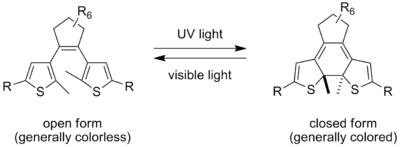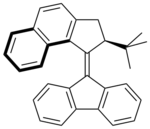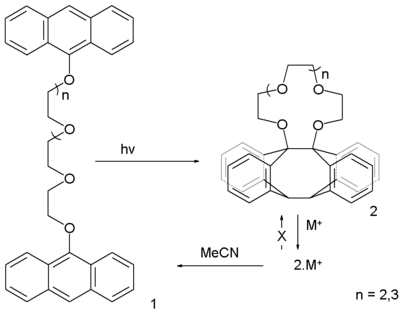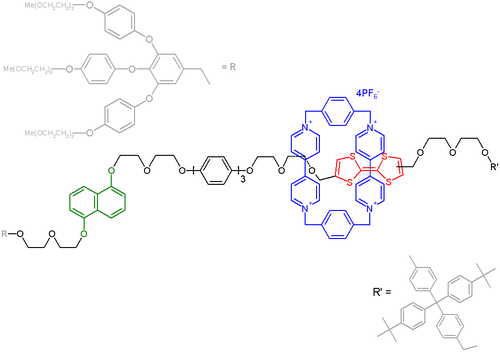
Molecular switch
Encyclopedia
A molecular switch is a molecule
that can be reversibly
shifted between two or more stable states. The molecules may be shifted between the states in response to changes in e.g. pH, light, temperature, an electrical current, microenvironment, or the presence of a ligand
. In some cases, a combination of stimuli are utilized. The oldest forms of synthetic molecular switches are pH indicator
s, which display distinct colors as a function of pH
. Currently synthetic molecular switches are of interest in the field of nanotechnology for application in molecular computers. Molecular switches are also important to in biology
because many biological functions are based on it, for instance allosteric regulation
and vision
. They are also one of the simplest examples of molecular machine
s.
. Members of this class include azobenzene
s, diarylethene
s, dithienylethenes, fulgides, stilbene
s, spiropyrans and phenoxynaphthacene quinones.
Chiroptical molecular switches are a specific subgroup with photochemical switching taking place between an enantiomeric pairs
. In these compounds the readout is by circular dichroism
rather than by ordinary spectroscopy. Hindered alkenes such as the one depicted below change their helicity
(see: planar chirality
) as response to irradiation with right or left-handed circularly polarized light
Chiroptical molecular switches that show directional motion are considered synthetic molecular motors
:
the bistable states of molecular switches differ in their affinity for guests. Many early examples of such systems are based on crown ether
chemistry. The first switchable host is described in 1978 by Desvergne & Bouas-Laurent who create a crown ether via photochemical anthracene
dimerization. Although not strictly speaking switchable the compound is able to take up cations after a photochemical trigger and exposure to acetonitrile
gives back the open form.
In 1980 Yamashita et al. construct a crown ether already incorporating the anthracene units (an anthracenophane) and also study ion uptake vs photochemistry.
Also in 1980 Shinkai throws out the anthracene unit as photoantenna in favor of an azobenzene
moiety and for the first time envisions the existence of molecules with an on-off switch. In this molecule light triggers a trans-cis isomerization of the azo group which results in ring expansion. Thus in the trans form the crown binds preferentially to ammonium
, lithium
and sodium
ions while in the cis form the preference is for potassium
and rubidium
(both larger ions in same alkali metal
group). In the dark the reverse isomerization takes place.
Shinkai employs this devices in actual ion transport mimicking the biochemical action of monensin
and nigericin
: in a biphasic system ions are taken up triggered by light in one phase and deposited in the other phase in absence of light.
where the bistable states differ in the position of the macrocycle. In 1991 Stoddart devices a molecular shuttle
based on a rotaxane
on which a molecular bead is able to shuttle between two docking stations situated on a molecular thread. Stoddart predicts that when the stations are dissimilar with each of the stations addressed by a different external stimulus the shuttle becomes a molecular machine. In 1993 Stoddart is scooped by supramolecular chemistry pioneer Fritz Vögtle who actually delivers a switchable molecule based not on a rotaxane but on a related catenane
This compound is based on two ring systems: one ring holds the photoswichable azobenzene ring and two paraquat
docking stations and the other ring is a polyether with to arene rings with binding affinity for the paraquat units. In this system NMR spectroscopy
shows that in the azo trans-form the polyether ring is free to rotate around its partner ring but then when a light trigger activates the cis azo form this rotation mode is stopped
Kaifer and Stoddart in 1994 modify their molecular shuttle
such a way that an electron-poor tetracationic cyclophane bead now has a choice between two docking stations: one biphenol and one benzidine
unit. In solution at room temperature NMR spectroscopy
reveals that the bead shuttles at a rate comparable to the NMR timescale, reducing the temperature to 229K resolves the signals with 84% of the population favoring the benzidine station. However on addition of trifluoroacetic acid
, the benzidine nitrogen atoms are protonated and the bead is fixed permanently on the biphenol station. The same effect is obtained by electrochemical
oxidation (forming the benzidine radical ion
) and significantly both processes are reversible.
In 2007 molecular shuttles are utilized in an experimental DRAM circuit
. The device consists of 400 bottom silicon
nanowire
electrode
s (16 nanometer (nm) wide at 33 nm intervals) crossed by another 400 titanium
top-nanowires with similar dimensions sandwiching a monolayer
of a bistable rotaxane depicted below:
Each bit
in the device consists of a silicon and a titanium crossbar with around 100 rotaxane molecules filling in the space between them at perpendicular angles. The hydrophilic diethylene glycol
stopper on the left (gray) is specifically designed to anchor to silicon wire (made hydrophilic by phosphorus doping) while the hydrophobic tetraarylmethane
stopper on the right does the same to the likewise hydrophobic titanium wire. In the ground state of the switch, the paraquat ring is located around a tetrathiafulvalene
unit (in red) but it moves to the dioxynaphthyl
unit (in green) when the fulvalene unit is oxidized by application of a current. When the fulvalene is reduced back a metastable high conductance '1' state is formed which relaxes back to the ground state with a chemical half-life of around one hour. The problem of defects is circumvented by adopting a defect-tolerant architecture also found in the Teramac
project. In this way a circuit is obtained consisting of 160,000 bits on an area the size of a white blood cell
translating into 1011 bits per square centimeter.
Molecule
A molecule is an electrically neutral group of at least two atoms held together by covalent chemical bonds. Molecules are distinguished from ions by their electrical charge...
that can be reversibly
Reversible reaction
A reversible reaction is a chemical reaction that results in an equilibrium mixture of reactants and products. For a reaction involving two reactants and two products this can be expressed symbolically as...
shifted between two or more stable states. The molecules may be shifted between the states in response to changes in e.g. pH, light, temperature, an electrical current, microenvironment, or the presence of a ligand
Ligand
In coordination chemistry, a ligand is an ion or molecule that binds to a central metal atom to form a coordination complex. The bonding between metal and ligand generally involves formal donation of one or more of the ligand's electron pairs. The nature of metal-ligand bonding can range from...
. In some cases, a combination of stimuli are utilized. The oldest forms of synthetic molecular switches are pH indicator
PH indicator
A pH indicator is a halochromic chemical compound that is added in small amounts to a solution so that the pH of the solution can be determined visually. Hence a pH indicator is a chemical detector for hydronium ions or hydrogen ions in the Arrhenius model. Normally, the indicator causes the...
s, which display distinct colors as a function of pH
PH
In chemistry, pH is a measure of the acidity or basicity of an aqueous solution. Pure water is said to be neutral, with a pH close to 7.0 at . Solutions with a pH less than 7 are said to be acidic and solutions with a pH greater than 7 are basic or alkaline...
. Currently synthetic molecular switches are of interest in the field of nanotechnology for application in molecular computers. Molecular switches are also important to in biology
Biology
Biology is a natural science concerned with the study of life and living organisms, including their structure, function, growth, origin, evolution, distribution, and taxonomy. Biology is a vast subject containing many subdivisions, topics, and disciplines...
because many biological functions are based on it, for instance allosteric regulation
Allosteric regulation
In biochemistry, allosteric regulation is the regulation of an enzyme or other protein by binding an effector molecule at the protein's allosteric site . Effectors that enhance the protein's activity are referred to as allosteric activators, whereas those that decrease the protein's activity are...
and vision
Visual perception
Visual perception is the ability to interpret information and surroundings from the effects of visible light reaching the eye. The resulting perception is also known as eyesight, sight, or vision...
. They are also one of the simplest examples of molecular machine
Molecular machine
A molecular machine, or nanomachine, is any discrete number of molecular components that produce quasi-mechanical movements in response to specific stimuli . The expression is often more generally applied to molecules that simply mimic functions that occur at the macroscopic level...
s.
Photochromic molecular switches
A widely studied class are photochromic compounds which are able to switch between electronic configurations when irradiated by light of a specific wavelength. Each state has a specific absorption maximum which can then be read out by UV-VIS spectroscopyUltraviolet-visible spectroscopy
Ultraviolet-visible spectroscopy or ultraviolet-visible spectrophotometry refers to absorption spectroscopy or reflectance spectroscopy in the ultraviolet-visible spectral region. This means it uses light in the visible and adjacent ranges...
. Members of this class include azobenzene
Azobenzene
Azobenzene is a chemical compound composed of two phenyl rings linked by a N=N double bond. It is the best known example of an azo compound. The term 'azobenzene' or simply 'azo' is often used to refer to a wide class of molecules that share the core azobenzene structure, with different chemical...
s, diarylethene
Diarylethene
In chemistry, diarylethene is the general name of a class of compounds that have aromatic groups bonded to each end of a carbon-carbon double bond...
s, dithienylethenes, fulgides, stilbene
Stilbene
-Stilbene, is a diarylethene, i.e., a hydrocarbon consisting of a trans ethene double bond substituted with a phenyl group on both carbon atoms of the double bond. The name stilbene is derived from the Greek word stilbos, which means shining....
s, spiropyrans and phenoxynaphthacene quinones.
Chiroptical molecular switches are a specific subgroup with photochemical switching taking place between an enantiomeric pairs
Enantiomer
In chemistry, an enantiomer is one of two stereoisomers that are mirror images of each other that are non-superposable , much as one's left and right hands are the same except for opposite orientation. It can be clearly understood if you try to place your hands one over the other without...
. In these compounds the readout is by circular dichroism
Circular dichroism
Circular dichroism refers to the differential absorption of left and right circularly polarized light. This phenomenon was discovered by Jean-Baptiste Biot, Augustin Fresnel, and Aimé Cotton in the first half of the 19th century. It is exhibited in the absorption bands of optically active chiral...
rather than by ordinary spectroscopy. Hindered alkenes such as the one depicted below change their helicity
Helicity
The term helicity has several meanings. In physics, all referring to a phenomenon that resembles a helix. See:*helicity , the extent to which corkscrew-like motion occurs...
(see: planar chirality
Planar chirality
Planar chirality is the special case of chirality for two dimensions.Most fundamentally, planar chirality is a mathematical term, finding use in chemistry, physics and related physical sciences, for example, in astronomy, optics and metamaterials...
) as response to irradiation with right or left-handed circularly polarized light
Chiroptical molecular switches that show directional motion are considered synthetic molecular motors
Synthetic molecular motors
Synthetic molecular motors are molecular machines capable of rotation under energy input. Although the term "molecular motor" has traditionally referred to a naturally occurring protein that induces motion , some groups also use the term when referring to non-biological, non-peptide synthetic...
:
Host-guest molecular switches
In host-guest chemistryHost-guest chemistry
In supramolecular chemistry, host-guest chemistry describes complexes that are composed of two or more molecules or ions that are held together in unique structural relationships by forces other than those of full covalent bonds. Host-guest chemistry encompasses the idea of molecular recognition...
the bistable states of molecular switches differ in their affinity for guests. Many early examples of such systems are based on crown ether
Crown ether
Crown ethers are cyclic chemical compounds that consist of a ring containing several ether groups. The most common crown ethers are oligomers of ethylene oxide, the repeating unit being ethyleneoxy, i.e., -CH2CH2O-. Important members of this series are the tetramer , the pentamer , and the hexamer...
chemistry. The first switchable host is described in 1978 by Desvergne & Bouas-Laurent who create a crown ether via photochemical anthracene
Anthracene
Anthracene is a solid polycyclic aromatic hydrocarbon consisting of three fused benzene rings. It is a component of coal-tar. Anthracene is used in the production of the red dye alizarin and other dyes...
dimerization. Although not strictly speaking switchable the compound is able to take up cations after a photochemical trigger and exposure to acetonitrile
Acetonitrile
Acetonitrile is the chemical compound with formula . This colourless liquid is the simplest organic nitrile. It is produced mainly as a byproduct of acrylonitrile manufacture...
gives back the open form.
In 1980 Yamashita et al. construct a crown ether already incorporating the anthracene units (an anthracenophane) and also study ion uptake vs photochemistry.
Also in 1980 Shinkai throws out the anthracene unit as photoantenna in favor of an azobenzene
Azobenzene
Azobenzene is a chemical compound composed of two phenyl rings linked by a N=N double bond. It is the best known example of an azo compound. The term 'azobenzene' or simply 'azo' is often used to refer to a wide class of molecules that share the core azobenzene structure, with different chemical...
moiety and for the first time envisions the existence of molecules with an on-off switch. In this molecule light triggers a trans-cis isomerization of the azo group which results in ring expansion. Thus in the trans form the crown binds preferentially to ammonium
Ammonium
The ammonium cation is a positively charged polyatomic cation with the chemical formula NH. It is formed by the protonation of ammonia...
, lithium
Lithium
Lithium is a soft, silver-white metal that belongs to the alkali metal group of chemical elements. It is represented by the symbol Li, and it has the atomic number 3. Under standard conditions it is the lightest metal and the least dense solid element. Like all alkali metals, lithium is highly...
and sodium
Sodium
Sodium is a chemical element with the symbol Na and atomic number 11. It is a soft, silvery-white, highly reactive metal and is a member of the alkali metals; its only stable isotope is 23Na. It is an abundant element that exists in numerous minerals, most commonly as sodium chloride...
ions while in the cis form the preference is for potassium
Potassium
Potassium is the chemical element with the symbol K and atomic number 19. Elemental potassium is a soft silvery-white alkali metal that oxidizes rapidly in air and is very reactive with water, generating sufficient heat to ignite the hydrogen emitted in the reaction.Potassium and sodium are...
and rubidium
Rubidium
Rubidium is a chemical element with the symbol Rb and atomic number 37. Rubidium is a soft, silvery-white metallic element of the alkali metal group. Its atomic mass is 85.4678. Elemental rubidium is highly reactive, with properties similar to those of other elements in group 1, such as very rapid...
(both larger ions in same alkali metal
Alkali metal
The alkali metals are a series of chemical elements in the periodic table. In the modern IUPAC nomenclature, the alkali metals comprise the group 1 elements, along with hydrogen. The alkali metals are lithium , sodium , potassium , rubidium , caesium , and francium...
group). In the dark the reverse isomerization takes place.
Shinkai employs this devices in actual ion transport mimicking the biochemical action of monensin
Monensin
Monensin is a polyether antibiotic isolated from Streptomyces cinnamonensis. It is widely used in animal feeds.The structure of monensin was first described by Agtarap et al. in 1967, and was the first polyether antibiotic to have its structure elucidated in this way...
and nigericin
Nigericin
Nigericin is an antibiotic derived from Streptomyces hygroscopicus. Its isolation was described in the 1950s, and in 1968 the structure could be elucidated by X-ray crystallography. The structure and properties of nigericin are similar to the antibiotic monensin. Commercially it is obtained as a...
: in a biphasic system ions are taken up triggered by light in one phase and deposited in the other phase in absence of light.
Mechanically-interlocked molecular switches
Some of the most advanced molecular switches are based on mechanically-interlocked molecular architecturesMechanically-interlocked molecular architectures
Mechanically interlocked molecular architectures are connections of molecules not through traditional bonds, but instead as a consequence of their topology. This connection of molecules is analogous to keys on a key chain loop. The keys are not directly connected to the key chain loop but they...
where the bistable states differ in the position of the macrocycle. In 1991 Stoddart devices a molecular shuttle
Molecular shuttle
A molecular shuttle in supramolecular chemistry is a special type of molecular machine capable of shuttling molecules or ions from one location to another. This field is of relevance to nanotechnology in its quest for nanoscale electronic components and also to biology where many biochemical...
based on a rotaxane
Rotaxane
A rotaxane is a mechanically-interlocked molecular architecture consisting of a "dumbbell shaped molecule" which is threaded through a "macrocycle" . The name is derived from the Latin for wheel and axle...
on which a molecular bead is able to shuttle between two docking stations situated on a molecular thread. Stoddart predicts that when the stations are dissimilar with each of the stations addressed by a different external stimulus the shuttle becomes a molecular machine. In 1993 Stoddart is scooped by supramolecular chemistry pioneer Fritz Vögtle who actually delivers a switchable molecule based not on a rotaxane but on a related catenane
Catenane
A catenane is a mechanically-interlocked molecular architecture consisting of two or more interlocked macrocycles. The interlocked rings cannot be separated without breaking the covalent bonds of the macrocycles. Catenane is derived from the Latin catena meaning "chain"...
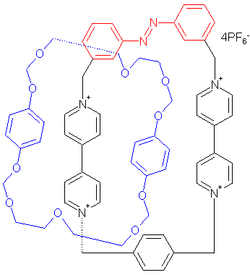 |
|valign=top | |
|
| Photo switchable catenane Vögtle 1993 | Molecular switch Kaifer and Stoddart 1994 | |
This compound is based on two ring systems: one ring holds the photoswichable azobenzene ring and two paraquat
Paraquat
Paraquat is the trade name for N,N′-dimethyl-4,4′-bipyridinium dichloride, one of the most widely used herbicides in the world. Paraquat, a viologen, is quick-acting and non-selective, killing green plant tissue on contact. It is also toxic to human beings and animals...
docking stations and the other ring is a polyether with to arene rings with binding affinity for the paraquat units. In this system NMR spectroscopy
NMR spectroscopy
Nuclear magnetic resonance spectroscopy, most commonly known as NMR spectroscopy, is a research technique that exploits the magnetic properties of certain atomic nuclei to determine physical and chemical properties of atoms or the molecules in which they are contained...
shows that in the azo trans-form the polyether ring is free to rotate around its partner ring but then when a light trigger activates the cis azo form this rotation mode is stopped
Kaifer and Stoddart in 1994 modify their molecular shuttle
Molecular shuttle
A molecular shuttle in supramolecular chemistry is a special type of molecular machine capable of shuttling molecules or ions from one location to another. This field is of relevance to nanotechnology in its quest for nanoscale electronic components and also to biology where many biochemical...
such a way that an electron-poor tetracationic cyclophane bead now has a choice between two docking stations: one biphenol and one benzidine
Benzidine
Benzidine, the trivial name for 4,4'-diaminobiphenyl, is the solid organic compound with the formula 2. This aromatic amine is a component of a test for cyanide and also in the production of dyes...
unit. In solution at room temperature NMR spectroscopy
NMR spectroscopy
Nuclear magnetic resonance spectroscopy, most commonly known as NMR spectroscopy, is a research technique that exploits the magnetic properties of certain atomic nuclei to determine physical and chemical properties of atoms or the molecules in which they are contained...
reveals that the bead shuttles at a rate comparable to the NMR timescale, reducing the temperature to 229K resolves the signals with 84% of the population favoring the benzidine station. However on addition of trifluoroacetic acid
Trifluoroacetic acid
Trifluoroacetic acid is the simplest stable perfluorinated carboxylic acid chemical compound, with the formula CF3CO2H. It is a strong carboxylic acid due to the influence of the electronegative trifluoromethyl group. TFA is almost 100,000-fold more acidic than acetic acid...
, the benzidine nitrogen atoms are protonated and the bead is fixed permanently on the biphenol station. The same effect is obtained by electrochemical
Electrosynthesis
Electrosynthesis in organic chemistry is the synthesis of chemical compounds in a electrochemical cell The main advantage of electrosynthesis over an ordinary redox reaction is avoidance of the potential wasteful other half-reaction and the ability to precisely tune the required potential...
oxidation (forming the benzidine radical ion
Radical ion
A radical ion is a free radical species that carries a charge. Radical ions are encountered in organic chemistry as reactive intermediates and in mass spectrometry as gas phase ions...
) and significantly both processes are reversible.
In 2007 molecular shuttles are utilized in an experimental DRAM circuit
Dram
Dram or DRAM may refer to:As a unit of measure:* Dram , an imperial unit of mass and volume* Armenian dram, a monetary unit* Dirham, a unit of currency in several Arab nationsOther uses:...
. The device consists of 400 bottom silicon
Silicon
Silicon is a chemical element with the symbol Si and atomic number 14. A tetravalent metalloid, it is less reactive than its chemical analog carbon, the nonmetal directly above it in the periodic table, but more reactive than germanium, the metalloid directly below it in the table...
nanowire
Nanowire
A nanowire is a nanostructure, with the diameter of the order of a nanometer . Alternatively, nanowires can be defined as structures that have a thickness or diameter constrained to tens of nanometers or less and an unconstrained length. At these scales, quantum mechanical effects are important —...
electrode
Electrode
An electrode is an electrical conductor used to make contact with a nonmetallic part of a circuit...
s (16 nanometer (nm) wide at 33 nm intervals) crossed by another 400 titanium
Titanium
Titanium is a chemical element with the symbol Ti and atomic number 22. It has a low density and is a strong, lustrous, corrosion-resistant transition metal with a silver color....
top-nanowires with similar dimensions sandwiching a monolayer
Monolayer
- Chemistry :A Langmuir monolayer or insoluble monolayer is a one-molecule thick layer of an insoluble organic material spread onto an aqueous subphase. Traditional compounds used to prepare Langmuir monolayers are amphiphilic materials that possess a hydrophilic headgroup and a hydrophobic tail...
of a bistable rotaxane depicted below:
Each bit
Bit
A bit is the basic unit of information in computing and telecommunications; it is the amount of information stored by a digital device or other physical system that exists in one of two possible distinct states...
in the device consists of a silicon and a titanium crossbar with around 100 rotaxane molecules filling in the space between them at perpendicular angles. The hydrophilic diethylene glycol
Diethylene glycol
Diethylene glycol is an organic compound with the formula 2O. It is a colorless, practically odorless, poisonous, and hygroscopic liquid with a sweetish taste. It is miscible in water, alcohol, ether, acetone, and ethylene glycol. DEG is a widely used solvent...
stopper on the left (gray) is specifically designed to anchor to silicon wire (made hydrophilic by phosphorus doping) while the hydrophobic tetraarylmethane
Tetraphenylmethane
Tetraphenylmethane is an organic compound consisting of a methane core with four phenyl substituents. It was first synthesized by Moses Gomberg in 1898....
stopper on the right does the same to the likewise hydrophobic titanium wire. In the ground state of the switch, the paraquat ring is located around a tetrathiafulvalene
Tetrathiafulvalene
Tetrathiafulvalene is a organosulfur compound with the formula 2. Studies on this heterocyclic compound contributed to the development of molecular electronics. TTF is related to the hydrocarbon fulvalene, 2, by replacement of four CH groups with sulfur atoms...
unit (in red) but it moves to the dioxynaphthyl
Naphthalene
Naphthalene is an organic compound with formula . It is a white crystalline solid with a characteristic odor that is detectable at concentrations as low as 0.08 ppm by mass. As an aromatic hydrocarbon, naphthalene's structure consists of a fused pair of benzene rings...
unit (in green) when the fulvalene unit is oxidized by application of a current. When the fulvalene is reduced back a metastable high conductance '1' state is formed which relaxes back to the ground state with a chemical half-life of around one hour. The problem of defects is circumvented by adopting a defect-tolerant architecture also found in the Teramac
Teramac
The Teramac was an experimental massively parallel computer designed by HP in the 1990s. The name reflected the project's vision to provide a programmable gate array system with capacity for a million gates running at a megahertz...
project. In this way a circuit is obtained consisting of 160,000 bits on an area the size of a white blood cell
White blood cell
White blood cells, or leukocytes , are cells of the immune system involved in defending the body against both infectious disease and foreign materials. Five different and diverse types of leukocytes exist, but they are all produced and derived from a multipotent cell in the bone marrow known as a...
translating into 1011 bits per square centimeter.


